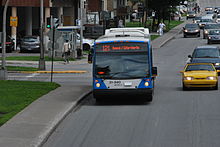Société de transport de Montréal
| Société de transport de Montréal | |
|---|---|
|
|
|
| Basic information | |
| Company headquarters | Montreal, Quebec Canada |
| Web presence | STM website |
| Reference year | 1861 |
| Board | Yves Devin, chairman |
| Lines | |
| Subway | 4th |
| bus | 197 |
| statistics | |
| Stops | 68 (subway) |
| Residents in the catchment area |
3.8 million |
The Société de transport de Montréal ( English rather seldom: Montreal Transit Corporation , German : Transportgesellschaft Montreal ; abbreviated to STM ) is a transport company that operates in the Canadian city of Montreal and its suburbs. It uses buses and operates the Montreal Metro . STM operates the fourth largest public transportation network in North America , after the New York City Transit Authority , Toronto Transit Commission and the Mexico City Metro . In 2011, an average of 2,524,500 passengers used STM vehicles every day.
history
Before the STM was founded, several smaller companies operated horse-drawn carriage connections. The Montreal City Passenger Railway Company began operating between 1861 and 1886 . In 1886 the company was renamed the Montreal Street Railway Company . The first electric tram ran in 1892, which was also known as the Rocket . In 1893 the company was renamed again. Which now traded under the name Montreal Island Beltline Railway . A year later the network was fully electrified, so that in 1894 the last horse-powered line was discontinued. In 1910, the company was renamed Montreal Public Service Corporation shortly thereafter to Montreal Tramways Company .
On January 1, 2002, 27 previously independent communities on the Île de Montréal were incorporated into the city of Montreal. Since then, the company has been called Société de transport de Montréal, or STM for short. Previously, the company was called Société de transport de la communauté urbaine de Montréal , abbreviated STCUM (English Montreal Urban Community Transit Corporation , abbreviated MUCTC ; German about transport company of the urban community of Montreal ).
On January 1, 2006, this merger was largely reversed; many of these parishes became independent from the city of Montreal again. However, this did not change anything in the services of the STM, which continues to serve these communities mainly located in the West Iceland region.
links
Rail transport
The Montreal Metro has four lines. Line 1 (green) runs from the Honoré-Beaugrand underground station to the Angrignon terminus . Line 2 (Orange) starts at Montmorency station and ends at the Côte-Vertu . Line 3 (yellow) runs from the Berri-UQAM underground station and ends at Longueuil-Université-de-Sherbrooke . Line 4 (blue) starts at Saint-Michel station and ends at Snowdon station .
Bus transport
STM operates over 200 bus routes and transports 1,403,700 people per day. The network has local scheduled connections with the line numbers 10–249. The buses run seven days a week, starting at 5:00 a.m. and ending at 1:00 a.m. on the next working day. During peak times, these buses run every 10 minutes. At the weekend, the buses run at longer intervals. Bus routes 251 to 263 have been specially set up for older citizens .
The night bus routes with the line numbers 300–399 run at night between 1:00 and 5:00, seven days a week.
The express routes with line numbers 400–499 do not stop at every stop. They are set up as Metrobus and Trainbus and connect parts of the city with centrally located transfer stations.
Lines 700–799 serve as special lines for tourist purposes and special traffic for larger events. The routes lead to popular tourist spots such as Old Montreal and La Ronde . In addition, line 747 runs every 8 to minutes during the day and every 30 minutes in the morning and evening between the city center and Pierre Elliott Trudeau Airport .
Vehicle fleet
STM has a fleet of around 1,600 buses. The buses used today come from Motor Coach Industries and Nova Bus . These are conventional as well as low-floor and articulated buses.
Web links
- Official website (English / French)

